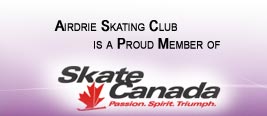





Prelim Prep
Ice Etiquette & Safety Guidelines
Skating is basically an individual sport, and activities during most practice sessions are pretty unstructured. It is important to know though, that some basic rules must be observed for safety, and to ensure that everyone can make effective use of their ice time.
Courtesy
First and foremost is courtesy. It is essential to respect
the rights of other skaters and be constantly aware of who is around
you. If you seem to be surrounded by skaters of significantly
greater or lesser skills, be
especially careful!
Strive to avoid collisions!
"On
Program" and "In Lesson" Get Priority
The skater who is "on program" (who's music is playing) has
the right of way at all times, and other skaters are expected to
give them free maneuvering room (This is the person in the bright
yellow vest). Second in priority are those skaters who are
currently in lessons with their pro. Always yield to these skaters
as well.
Lutz Corners
Because of the nature of the Lutz jump, it is most commonly
performed in the 10:00 and 4:00 corners of the rink. These corners
are informally called the "Lutz Corners", and can usually be
identified by the unusually large concentration of divots in the
ice. Strive to avoid long-term practice activities in these corners,
and try to be especially aware of your surroundings when you are in
them. Remember that the approach to a Lutz is long
and blind. The
skater doing the Lutz is not likely to see you.
Dangerous Singles Moves
When you are practicing elements like camel spins and back
spirals be especially aware of the danger your exposed blade poses
to other skaters. Recognize that once you've started the element it
will be hard for you to see those around you. Take a good look at
your expected "space" before you start the element, and abort it if
it looks like you could cause a problem.
Falls and Injuries
If you should fall, get up quickly. Remember that the other
skaters will have a much harder time seeing you when you are down
low on the ice. Don't stay there any longer than you have to. While
falling, remember to keep your fingers away from your blades. And
learn to fall properly so that you can protect your head as much as
possible. Learn to keep "loose" when you fall and this will help you
to avoid breaking things.
If you see someone else is that has fallen and may be injured, don't just drag them off without being certain that doing so won't hurt them further. If you suspect that someone is seriously hurt, the best thing to do is, 1) have someone stand "guard" over them to make sure that other skaters avoid collisions with them, and 2) get a qualified adult to come and help them. A blanket or warmup jacket/sweatshirt laid over them might help to keep them warmer while waiting for qualified help to arrive.
Predictability
As you skate more, you'll get to the point where you'll
recognize that a practice session has a certain "rhythm" to it.
People tend to do pretty "expectable" or "predictable" things, and
you can usually pretty much guess where somebody else is going,
based on what they're doing when you see them (the normal approaches
to each jump or spin are pretty recognizable). If you're a "wrong
way" skater (clockwise jumper) be aware that other skaters will
probably guess wrong about your intentions pretty often. If you have
clockwise jumpers in your rink, try to recognize them and adjust
your expectations accordingly. Try not to skate or behave in a way
that would surprise other skaters. If you're standing near the
boards, don't enter the flow of skaters without checking to make
sure you're not going to get into someone else's way.
Don't Stand Around
Refrain from standing around and visiting on the ice. This
wastes expensive ice and presents an additional hazard for other
skaters to avoid.
Contact: Richelle Rothecker Ph: 403-948-4230

